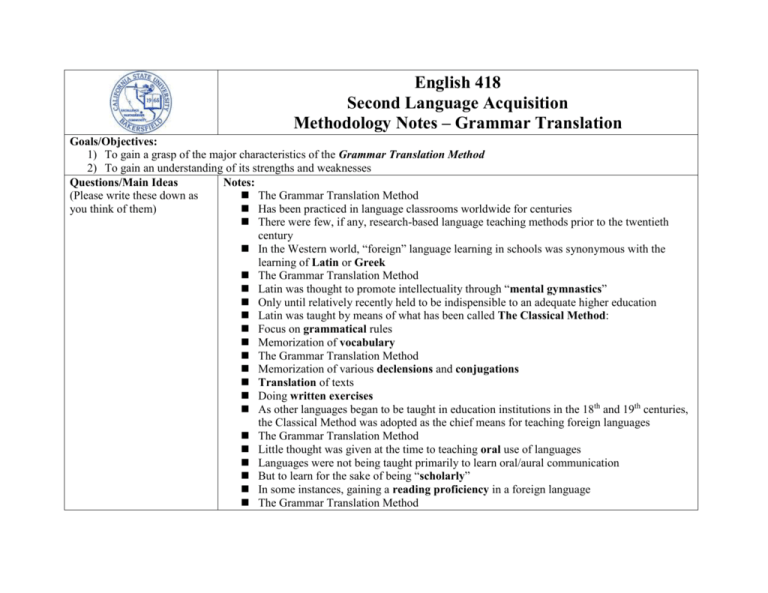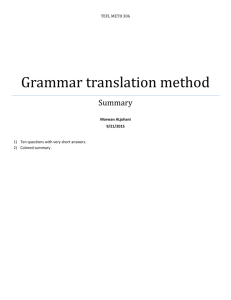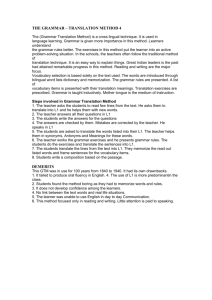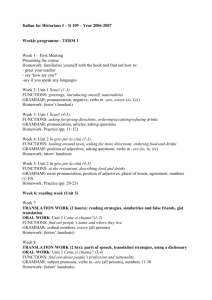English 418 Second Language Acquisition Methodology Notes
advertisement

English 418 Second Language Acquisition Methodology Notes – Grammar Translation Goals/Objectives: 1) To gain a grasp of the major characteristics of the Grammar Translation Method 2) To gain an understanding of its strengths and weaknesses Questions/Main Ideas Notes: (Please write these down as The Grammar Translation Method you think of them) Has been practiced in language classrooms worldwide for centuries There were few, if any, research-based language teaching methods prior to the twentieth century In the Western world, “foreign” language learning in schools was synonymous with the learning of Latin or Greek The Grammar Translation Method Latin was thought to promote intellectuality through “mental gymnastics” Only until relatively recently held to be indispensible to an adequate higher education Latin was taught by means of what has been called The Classical Method: Focus on grammatical rules Memorization of vocabulary The Grammar Translation Method Memorization of various declensions and conjugations Translation of texts Doing written exercises As other languages began to be taught in education institutions in the 18th and 19th centuries, the Classical Method was adopted as the chief means for teaching foreign languages The Grammar Translation Method Little thought was given at the time to teaching oral use of languages Languages were not being taught primarily to learn oral/aural communication But to learn for the sake of being “scholarly” In some instances, gaining a reading proficiency in a foreign language The Grammar Translation Method Since there was little if any theoretical research on second language acquisition in general Or on acquisition of reading proficiency in particular Foreign languages were taught as any other skill was taught (the teacher “explains,” the students “absorb”) The Grammar Translation Method In the 19th century, the Classical Method came to be known as The Grammar Translation Method There was little to distinguish Grammar Translation from what had gone on in foreign language classrooms for centuries, beyond a focus on grammatical rules as the basis for translating from the second to the native language The Grammar Translation Method But the Grammar Translation Method remarkably withstood attempts at the turn of the twentieth century to “reform” language teaching methodology To this day, it remains a standard methodology for language teaching in many institutions around the world The Grammar Translation Method Prator and Celce-Murcia list the major characteristics of Grammar Translation: 1. Classes are taught in the mother tongue, with little active use of the target language 2. Much vocabulary is taught in the form of isolated words 3. Long elaborate explanations of the intricacies of grammar are given The Grammar Translation Method 4. Grammar provides the rules for putting words together, and instruction often focuses on the form and inflection of words 5. Reading of difficult classical texts is begun early 6. Little attention is paid to the context of texts, which are treated as exercises in grammatical analysis The Grammar Translation Method 7. Often the only drills are exercises in translating disconnected sentences from the target language into the mother tongue 8. Little or no attention is given to pronunciation The Grammar Translation Method On one hand, it is remarkable that this method has been so stalwart among many competing models: It does virtually nothing to enhance a student’s communicative ability in the language The Grammar Translation Method It is remembered with distaste by thousands of school learners, for whom foreign language learning meant a tedious experience of memorizing endless lists of unusable grammar rules and vocabulary and attempting to produce perfect translations of stilted or literary prose The Grammar Translation Method However, in another sense, it is understandable why Grammar Translation remains so popular: It requires few specialized skills on the part of teachers Tests of grammar rules and of translations are easy to construct and can be objectively scored The Grammar Translation Method Many standardized tests of foreign languages still do not attempt to tap into communicative abilities, so students have little or no motivation to go beyond grammar analogies, translations, and rote exercises And it is sometimes successful in leading a student toward a reading knowledge of a second language The Grammar Translation Method Richard and Rogers point out: It has no advocates It is a method for which there is no theory There is no literature that offers a rationale or justification for it or that attempts to relate it to issues in linguistics, psychology, or educational theory Yet it remains a standard methodology around the world The Grammar Translation Method Therefore, as we examine other methodologies, they must be compared to this methodology (as well as the Audio-Lingual Method, as we will see) Summary/Minute Paper:






